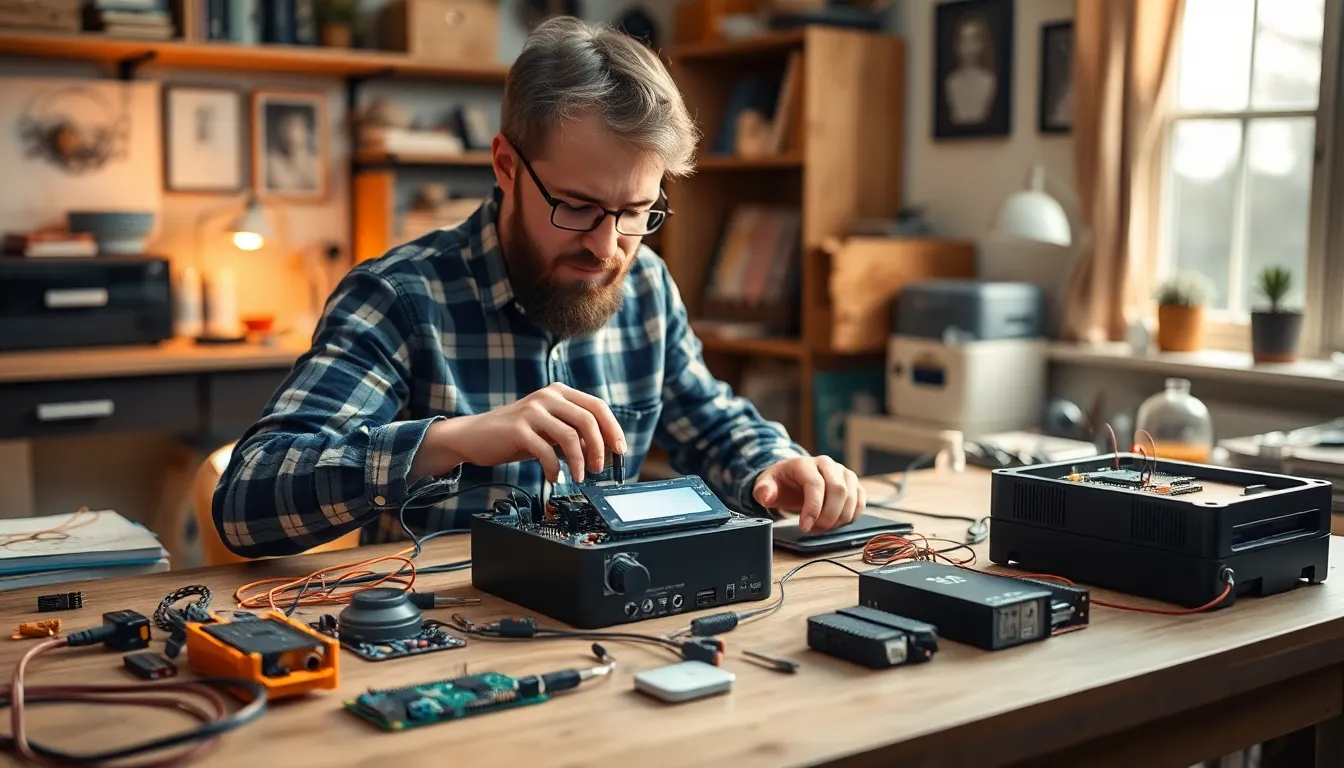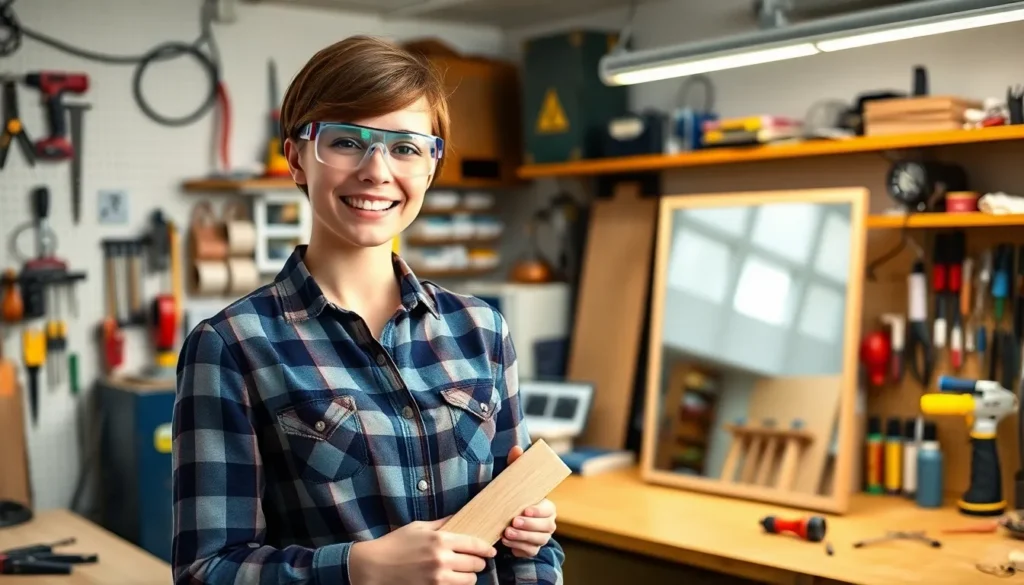In a world where gadgets rule our lives, why settle for store-bought when you can unleash your inner inventor? DIY home gadgets not only add a personal touch to your space but also save you some serious cash. Imagine impressing friends with a homemade smart mirror or a quirky automated plant-watering system—who needs a tech store when creativity is at your fingertips?
Crafting your own gadgets can feel like a scene from a sci-fi movie, minus the lab coat and crazy hair. Plus, it’s a great excuse to raid the junk drawer and transform that old toaster into a futuristic toast-launching device (okay, maybe not that extreme). Get ready to dive into the world of DIY home gadgets, where innovation meets fun, and every project is a chance to show off your skills.
Table of Contents
ToggleOverview of DIY Home Gadgets
DIY home gadgets represent a growing trend that empowers individuals to create tailored solutions for their living spaces. Crafting gadgets brings a personal touch that often lacks in store-bought options. Projects range from simple to complex, allowing crafters of all skill levels to participate.
Smart mirrors exemplify this trend, featuring integrated technology for enhanced functionality. Automated plant-watering systems are another popular choice, offering convenience for busy plant enthusiasts. Implementing such inventions not only saves money but also promotes sustainability by utilizing recycled materials.
Creativity shines through when individuals repurpose everyday items. For instance, transforming an old smartphone into a security camera can enhance home safety. Numerous tutorials are available online, making it easier for anyone to get started with DIY projects.
Time spent on these gadgets fosters innovation. Collaborating with family or friends can lead to shared ideas and collective brainstorming sessions, which often yield unique results. Benefits extend beyond the gadgets themselves; the learning process encourages problem-solving skills and boosts confidence.
From assembling custom shelving units to designing mood lighting, the possibilities are endless. Exploring the world of DIY home gadgets offers a fulfilling way to enhance one’s living environment. Engaging in these projects can spark joy, creating spaces that reflect unique personalities and preferences.
Popular DIY Home Gadgets

DIY home gadgets allow individuals to personalize spaces while adding functionality. Here are several popular choices that highlight creativity and innovation.
Smart Home Controls
Creating smart home controls maximizes convenience and efficiency. Homeowners can repurpose microcontrollers and sensors to automate tasks like adjusting thermostats or controlling appliances. Projects often include installing a Raspberry Pi with compatible apps to manage home systems remotely. Using these devices promotes energy savings and simplifies daily routines. Many resources provide step-by-step guidance for various skill levels. Communities also share ideas and improvements, enhancing the overall experience.
Automated Lighting Solutions
Automated lighting solutions enhance ambiance while providing energy efficiency. DIY enthusiasts can use smart bulbs that adjust brightness and color through smartphone apps. Incorporating motion sensors enables automatic activation when entering a room. Projects range from simple timers to complex systems that sync with daily schedules. Properly executed designs aim for both aesthetics and practicality. Online tutorials abound, catering to different expertise levels, ensuring that anyone can create functional lighting setups.
Tools and Materials for DIY Projects
Building DIY home gadgets requires specific tools and materials. Having the right items on hand streamlines the process, making it enjoyable and efficient.
Essential Tools for Beginners
A measuring tape ensures precise dimensions for every project. Utility knives easily cut various materials, while a cordless drill simplifies assembling components. Pliers come in handy for gripping and twisting, adding versatility to tasks. Screwdrivers, both flat and Phillips, are crucial for fastening parts securely. Finally, a soldering iron helps with electrical connections, allowing for custom wiring.
Recommended Materials
A variety of materials enhances DIY projects. Wood offers a sturdy base for shelving units and frames. Plastic containers serve perfectly for organizing small components. Wires and cables, along with connectors, allow for electronic configurations, bringing gadgets to life. Using recycled items, like jars or old electronics, encourages sustainability while providing inspiration. Adhesives, such as hot glue or epoxy, bond various elements, ensuring durability in creations.
Step-by-Step Guides for Popular Gadgets
Creating DIY home gadgets enhances creativity and personalizes spaces effectively. Below are detailed guides for popular DIY projects.
Creating a Smart Mirror
Start with a mirror and a display screen, such as an old tablet or monitor. Measure the mirror’s dimensions and cut a piece of plywood to serve as the frame. Mount the display behind the mirror, ensuring it aligns properly. Use a smart mirror software like MagicMirror² to configure the interface. Connect the display to a power source. Position the mirror in a well-lit area for optimal visibility. Customize the software settings for weather updates, news feeds, and other widgets. Users find this project not only functional but also a stylish addition to their home.
Building a DIY Security Camera
Select an old smartphone or a Raspberry Pi as the camera’s base. Install a security camera app on the smartphone or set up the necessary software on the Raspberry Pi. Position the camera at an optimal angle for monitoring. Use a stable mount or tripod for securing the device. Connect to the home Wi-Fi network for remote access. Check that video feeds work and adjust settings such as motion detection and alerts. Utilize cloud storage for recording footage, ensuring safety and accessibility. This project offers greater security while reusing technology effectively.
Tips for Successful DIY Projects
Choosing suitable projects starts with assessing skill levels and available materials. Beginners often find success in simple gadgets. More experienced crafters can tackle complex systems for advanced functionality. Understanding the purpose of the gadget ensures the project aligns with personal needs.
Gathering essential tools makes crafting easier. Measuring tapes, utility knives, and cordless drills are vital for precision. Selecting the right materials contributes to the gadget’s durability. For example, using recycled items promotes sustainability while adding character to creations.
Utilizing online resources enhances learning. Tutorials and forums offer step-by-step guidance from experienced DIY enthusiasts. Engaging with local maker communities provides support and inspiration. Collaborating with friends or family enriches the experience and can lead to innovative ideas.
Planning the project in detail helps streamline the building process. Creating a list of required materials and tools minimizes interruptions. Drawing a clear design or blueprint aids in visualizing the end product.
Starting with smaller tasks increases confidence. As familiarity grows, attempting more complicated gadgets becomes feasible. Celebrating small victories throughout the process keeps motivation high.
Testing functionality before final assembly ensures reliability. Making adjustments as necessary guarantees the gadget meets expectations. Reflecting on completed projects fosters creativity for future endeavors.
Persisting through challenges leads to satisfaction. Each obstacle conquered builds resilience and enhances skill. Sharing finished projects with others inspires and encourages continued exploration in the DIY world.
DIY home gadgets offer an exciting opportunity to blend creativity with functionality. By crafting personalized solutions, individuals can enhance their living spaces while saving money and promoting sustainability. The journey of creating gadgets like smart mirrors or automated plant-watering systems not only fosters innovation but also encourages collaboration among family and friends.
With a wealth of resources available, anyone can dive into the world of DIY projects, regardless of skill level. The satisfaction derived from transforming everyday items into unique inventions is unparalleled. Embracing this trend can lead to a more tailored and enjoyable home environment, reflecting personal style and ingenuity. The possibilities are endless, and the adventure of invention awaits.





